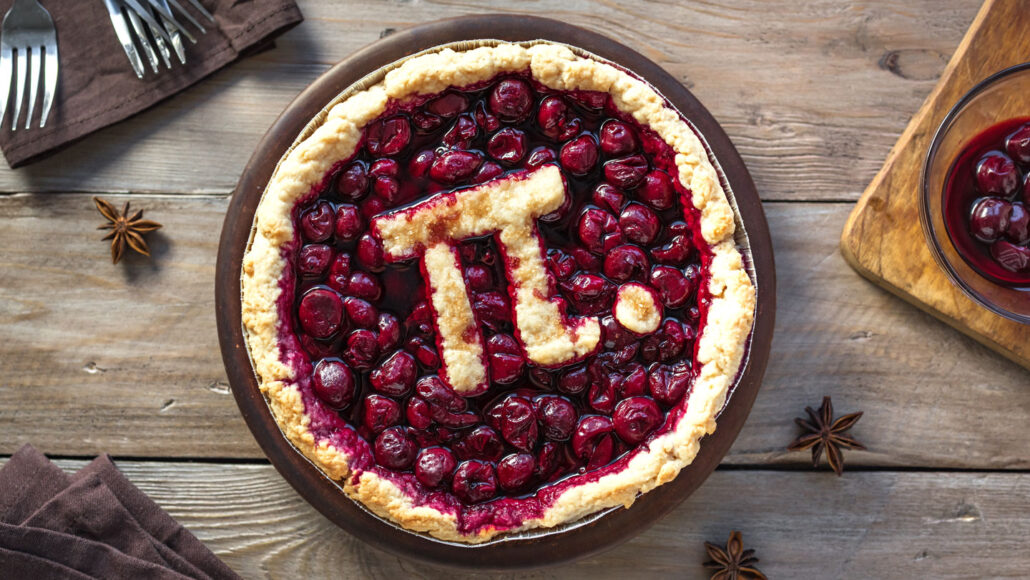Let’s learn about pi
This never-ending number is more than just circular pastry

Come to the math side. We have pi.
Mizina/iStock/Getty Images Plus
March 14 is right around the corner, and math geeks know what that means. It’s almost Pi Day. Not Pie Day — although Pi Day is a good excuse to eat circular treats. This holiday honors one of math’s most famous constants: pi.
The number pi, or π, is a ratio. It’s equal to the circumference of a circle divided by the circle’s diameter. That comes out to about 3.14159. This is true for circles of all sizes, from pennies to pizzas to planets. Pi’s value is often rounded to 3.14. That’s why Pi Day is celebrated on March 14, or 3/14. It’s also why one Earth-sized planet orbiting another star every 3.14 days is nicknamed “Pi Earth.”
But the exact value of pi is actually impossible to write out. Last year, a powerful computer calculated pi to a record-breaking 62.8 trillion digits. And in 2005, one 23-year-old used clever mental tricks to recite nearly 68,000 of those digits from memory. No one, though, will ever get to the end of pi. That’s because the string of digits after the decimal place goes on forever without repeating. This makes pi an irrational number.
Historians aren’t sure when people first discovered the concept of pi. But it’s been known in some form for almost 4,000 years. Ancient Greeks and Babylonians knew estimates of it. The Egyptians may have used pi to build the pyramids. And still today, pi is used in just about all math involving circles. It helps engineers plot the orbits of satellites. Physicists use it to understand particle smashups inside the loop of the Large Hadron Collider. Pi also helps describe other kinds of curves, such as light waves and sound waves.

Educators and Parents, Sign Up for The Cheat Sheet
Weekly updates to help you use Science News Explores in the learning environment
Thank you for signing up!
There was a problem signing you up.
Some people want to knock pi off its pedestal. They think another constant might make math easier to learn. That constant is tau, or τ. It is equal to 2π. In math, angles are often measured in radians. And while pi is the number of radians in half a circle, tau is the number of radians in a whole circle. So equations written with tau might help people understand and enjoy math more, tau supporters say.
Of course, a simple pi-to-tau switch may not win over true math-phobes. But if you’ve got anxiety about arithmetic, never fear. Science has revealed some ways to manage that stress. That way, you can have your pi and enjoy math, too.
Want to know more? We’ve got some stories to get you started:
Scientists Say: Pi This short explainer dishes up the basics on math’s most famous constant. (4/26/2021) Readability: 7.7
Meet ‘Pi’ — a new Earth-sized exoplanet The planet’s nickname refers to its 3.14-day orbit and its oven-warm surface temperature. (12/17/2020) Readability: 7.5
For these artists, math is their muse Meet a quilter who makes pi-inspired artwork. (6/6/2019) Readability: 7.4
Explore more
Explainer: The basics of geometry
Forget Pi Day. We should be celebrating Tau Day (Science News)
Pi master’s storied recall (Science News)
Activities
Every March 14, math nerds around the world celebrate Pi Day. (That’s because the date 3/14 includes the first three digits of pi.) Celebrate pi this day — or any other — with pi-themed logic and Sudoku puzzles and card games. Flex your memory skills with a song that lists the first 100 digits of pi. Or use pi to find the circumference of a baked pie — perhaps using Science News for Students’ favorite chocolate mousse pie recipe.







